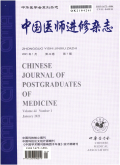重症肝炎并发自发性细菌性腹膜炎的临床分型及意义
Clinical classification of spontaneous bacterial peritonitis in patients with severe viral hepatitis and its significance
摘要目的 分析重症肝炎并发自发性细菌性腹膜炎(SBP)的临床特征,探讨其临床分型及意义.方法 回顾性分析120例重症肝炎并发SBP患者的临床表现,并根据初始出现的主要临床症状、体征进行临床分型.结果 SBP临床分型:普通型50例(41.7%),无症状型19例(15.8%),肝昏迷型16例(13.3%),顽固性腹水型21例(17.5%),休克型14例(11.7%).肝昏迷型及休克型腹水细菌培养阳性率较高,存活率较低.结论 重症肝炎并发SBP临床表现不典型,将其分成5型,有利于提高临床医师对SBP的认识,早期诊断,减少漏诊.肝昏迷型及休克型SBP预后差,临床上应高度重视.
更多相关知识
abstractsObjective To analyze the clinical characteristic of spontaneous bacterial peritonitis (SBP) in patients with severe viral hepatitis, and explore its clinical classification and significance. Methods A retrospective research of 120 cases of SBP associated with severe viral hepatitis was performed, and main clinical symptoms and physical signs appeared at the early onset were classified and explored. Results Clinical manifestations of SBP in patients with severe viral hepatitis included 5 types, which were conventional type(41.7%, 50/120), symptomless type(15.8%, 19/120), hepatic coma type(13.3%, 16/120), refractory aacites type (17.5%, 21/120), and shock type (11.7%, 14/120). The germieuhure positive rate of SBP with hepatic coma type and shock type were relatively high, and the survival rate of these patients were low. Conclusions Clinical manifestations of SBP in patients with severe viral hepatitis may be atypical, and its classification help to enhancing the understanding and early diagnosis of SBP, and decreasing missed diagnosis. The prognosis of SBP in patients with hepatic coma type and shock type was poor, and then it must be taken high into account more than ever before in the clinical practice.
More相关知识
- 浏览340
- 被引2
- 下载81


相似文献
- 中文期刊
- 外文期刊
- 学位论文
- 会议论文



 换一批
换一批 换一批
换一批



